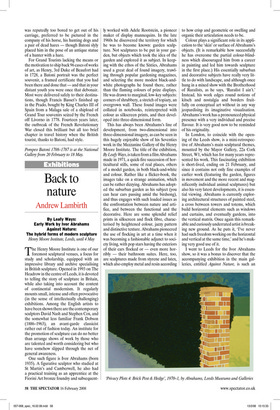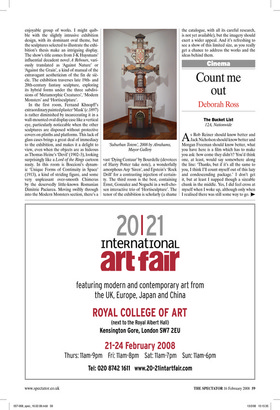Back to nature
Andrew Lambirth
By Leafy Ways: Early Work by Ivor Abrahams Against Nature: The hybrid forms of modern sculpture Henry Moore Institute, Leeds, until 4 May
The Henry Moore Institute is one of our foremost sculptural venues, a focus for study and scholarship, equipped with an impressive library and archive specialising in British sculpture. Opened in 1993 on The Headrow in the centre of Leeds, it is devoted to telling the story of sculpture in Britain, while also taking into account the context of continental modernism. It regularly mounts small, intense and often provocative (in the sense of intellectually challenging) exhibitions. Among the English artists to have been shown there are the contemporary sculptors David Nash and Stephen Cox, and the somewhat less familiar Frank Dobson (1886–1963), an avant-garde classicist rather out of fashion today. An institute for the promotion of sculpture can do no better than arrange shows of work by those who are talented and worth considering but who have somehow slipped through the net of general awareness.
One such figure is Ivor Abrahams (born 1935). A figurative sculptor who studied at St Martin’s and Camberwell, he also had a practical training as an apprentice at the Fiorini Art bronze foundry and subsequent ly worked with Adele Rootstein, a pioneer maker of display mannequins. In the late 1960s he discovered the territory for which he was to become known: garden sculpture. Not sculptures to be put in your garden, but objects which took the idea of the garden and explored it as subject. In keeping with the ethos of the Sixties, Abrahams used a great deal of found imagery, trawling through popular gardening magazines, and selecting the more modest black-andwhite photographs he found there, rather than the flaming colours of prize displays. He was drawn to marginal, low-key subjects: corners of shrubbery, a stretch of topiary, an overgrown wall. These found images were collated in notebooks, reinterpreted with colour as silkscreen prints, and then developed into three-dimensional form.
This has always been Abrahams’s line of development, from two-dimensional into three-dimensional imagery, as can be seen in this hugely enjoyable show of his Seventies work in the Mezzanine Gallery of the Henry Moore Institute. The title of the exhibition, By Leafy Ways, is taken from a film Abrahams made in 1971, a quick-fire succession of horticultural stills, some of real places, others of a model garden, in both black-and-white and colour. Rather like a flicker-book, the images take on a strange animation, which can be rather dizzying. Abrahams has adopted the suburban garden as his subject (you can hear cars passing amid the birdsong), and thus engages with such loaded issues as the confrontation between nature and artifice, and between the functional and the decorative. Here are some splendid relief prints in silkscreen and flock fibre, characterised by heightened colour, jazzy pattern and distinctive texture. Abrahams pioneered the use of flocking in art at a time when it was becoming a fashionable adjunct to society living, with pop stars having the exteriors of their cars flocked or — even more horribly — their bathroom suites. Here, too, are sculptures made from styrene and latex, which also employ metal and resin according to how crisp and geometric or swelling and organic their articulation needs to be.
Colour plays a significant role in its application to the ‘skin’ or surface of Abrahams’s objects. (It is remarkable how successfully he has overcome the partial colour-blindness which discouraged him from a career in painting and led him towards sculpture in the first place.) His essentially suburban and decorative subjects have really very little to do with landscape, and although once hung in a mixed show with the Brotherhood of Ruralists, as he says, ‘Ruralist I ain’t.’ Instead, his work edges round notions of kitsch and nostalgia and borders fruitfully on conceptual art without in any way jeopardising its imaginative visualisation. Abrahams’s work has a pronounced physical presence with a very individual and precise flavour. It is very good now to be reminded of his originality.
In London, to coincide with the opening of the Leeds show, is a mini-retrospective of Abrahams’s main sculptural themes, mounted by the Mayor Gallery, 22a Cork Street, W1, which has for many years represented his work. This fascinating exhibition is short-lived, ending on 21 February, and since it contains not only fine examples of earlier work (featuring the garden, figures in movement and the more recent and magnificently individual animal sculptures) but also his very latest developments, it is essential viewing. Abrahams is currently exploring architectural structures of painted steel, a cross between towers and totems, which build horizontal elements such as windows and curtains, and eventually gardens, into the vertical matrix. Once again this remarkable and curiously underrated artist is breaking new ground. As he puts it, ‘I’ve never had such freedom working on the horizontal and vertical at the same time,’ and he’s making very good use of it.
I went to Leeds for the Ivor Abrahams show, so it was a bonus to discover that the accompanying exhibition in the main galleries, entitled Against Nature, is such an enjoyable group of works. I might quibble with the slightly intrusive exhibition design, with its dominant oval theme, but the sculptures selected to illustrate the exhibition’s thesis make an intriguing display. The show’s title comes from J-K Huysmans’ influential decadent novel A Rebours, variously translated as ‘Against Nature’ or ‘Against the Grain’, a kind of manual of the extravagant aestheticism of the fin de siècle. The exhibition traverses late 19thand 20th-century fantasy sculpture, exploring its hybrid forms under the three subdivisions of ‘Metamorphic Creatures’, ‘Modern Monsters’ and ‘Hortisculpture’.
In the first room, Fernand Khnopff’s extraordinary painted plaster ‘Mask’ (c.1897) is rather diminished by incarcerating it in a wall-mounted oval display case like a vertical eye, particularly noticeable when the other sculptures are disposed without protective covers on plinths and platforms. This lack of glass cases brings a great deal of immediacy to the exhibition, and makes it a delight to view, even when the objects are as hideous as Thomas Heine’s ‘Devil’ (1902–3), looking surprisingly like a Lord of the Rings cartoon nasty. In this room is Boccioni’s dynamic ‘Unique Forms of Continuity in Space’ (1913), a kind of striding figure, and some very unpleasant over-smooth Chimeras by the deservedly little-known Romanian Dimitrie Paciurea. Moving swiftly through into the Modern Monsters section, there’s a vast ‘Dying Centaur’ by Bourdelle (devotees of Harry Potter take note), a wonderfully amorphous Arp ‘Siren’, and Epstein’s ‘Rock Drill’ for a contrasting injection of certainty. The third room is the best, containing Ernst, Gonzalez and Noguchi in a well-chosen interactive trio of ‘Hortisculpture’. The tenor of the exhibition is scholarly (a shame the catalogue, with all its careful research, is not yet available), but the imagery should exert a wider appeal. And it’s refreshing to see a show of this limited size, as you really get a chance to address the works and the ideas behind them.



















































































 Previous page
Previous page